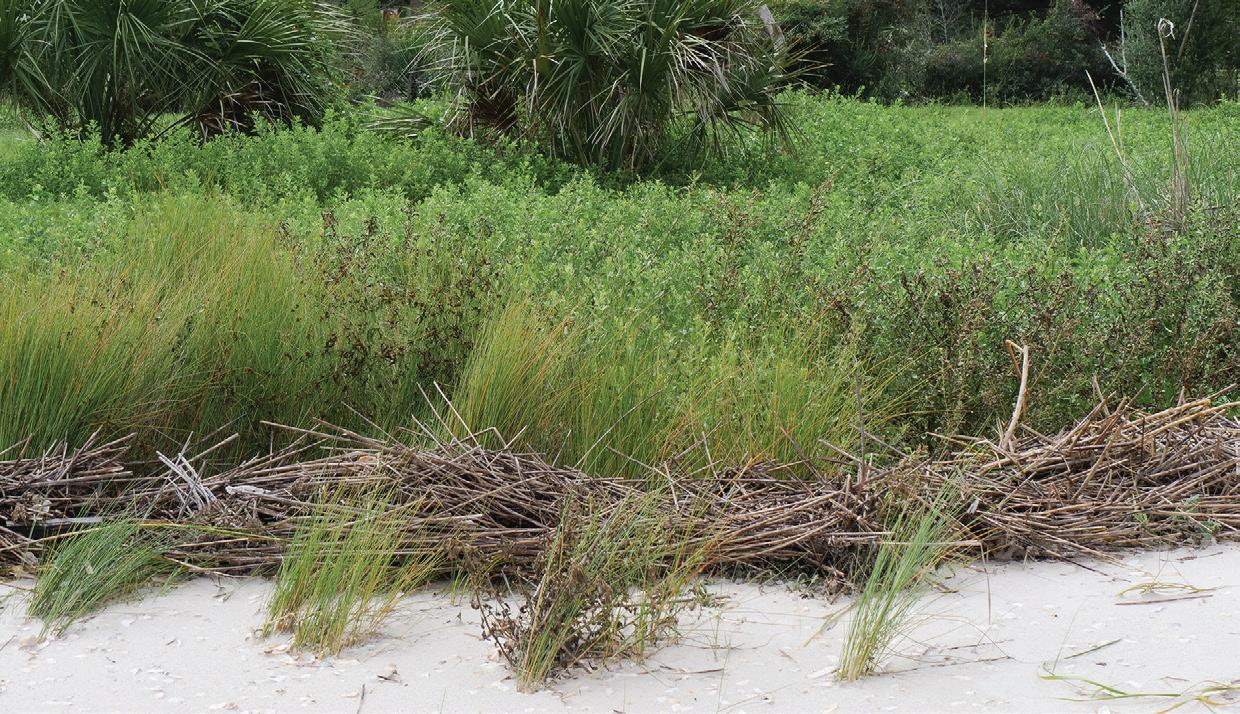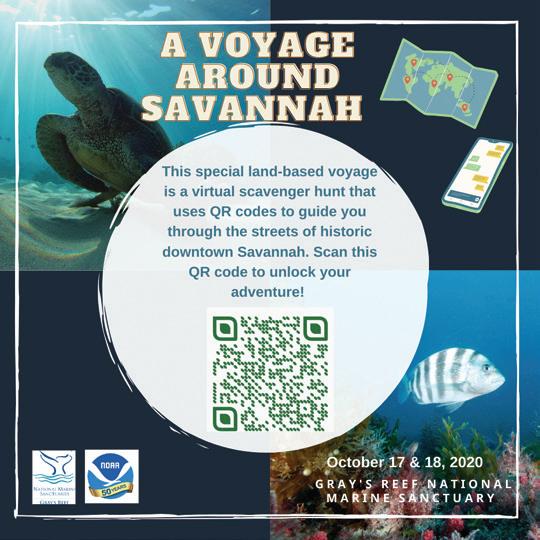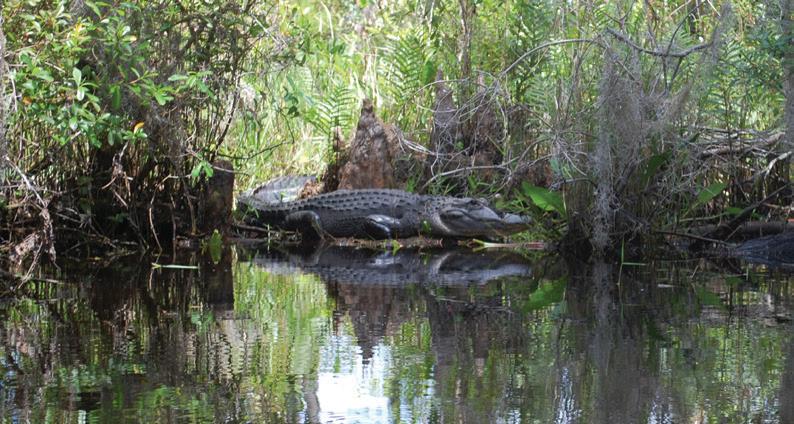
6 minute read
Exploring Coastal Ecosystems
Spartina grass in the low marsh is able to withstand twice daily tides.
Article and Photos By Captain J. Gary Hill
Advertisement
When we think of the lowcountry, the first thing that comes to mind is the flat verdant expanses of marsh grasses. The one hundred miles of the Georgia coast is one of the most intact, largest and pristine saltwater marshes in the country. Estimated at roughly half a million acres, extending from the barrier islands inland, in a straight line approximately seven to ten miles.
The average salinity of the ocean is about 35 parts per thousand (PPT) this sort of environment. There are a few native species that live in this tidal ecosystem. The biodiversity of the lowcountry is unique in that ecosystems, or rather micro-ecosystems, can be separated by mere inches where other ecosystems are separated by miles or even hundreds of miles.
The driving force for the salt marsh is the tide, and with Georgia having one of the largest tidal ranges on the east coast, our saltmarsh tends to be rather unique.
Starting at the ocean we have our first ecosystem, which is a marine system, loaded with fishes, crustaceans, marine mammals, corals and other assorted life.
At the oceans edge we have the barrier islands, which, as the name implies are barriers between the ocean and the interior. These islands shield us from the wrath of storms and winds and are dynamic landmasses, ever changing, yet critical to the survival of the saltmarsh in general.
Sea oats are critical vegetation on mainland and barrier island beaches. Their sturdy structure allows them to absorb the force of the wind, this decreases the impact and damage at the surface of the sand. However, the root system of this rhizomatous plant has a tap root that extends up to 12 feet deep, and spreads out like a spider’s web over an area of a 100 feet or more. Found on beach dunes, this plant can withstand salt for short periods of time, however, they cannot endure long periods of inundation. Please remember this is a protected plant, and when visiting the beach do not walk on, play with or remove any of this vitally important plant from its habitat.
As we move inland, we encounter the low marsh. This area receives the full effect of the rise and fall of the tides, which vary from an average of six to eight feet on normal days, to nine to ten feet or greater during spring tides or king tides (during new and full moons). Our tides can range even higher when storms push more sea water in.
Salt content in the marsh can be the same as seawater, however, may be a bit lower depending on the amount of freshwater in the mix, usually ranging from about 28-35 PPT. It takes very specialized plants to live here, such as Spartina sporobolus, (the marsh grass formerly known as Spartina alterniflora). Spartina is able to endure several hours a day submerged in salt water. Imagine if you took a bucket of seawater and dumped it on a rose bush. Not so good for Mr. Rose.
Next we start to move inland, though not by miles, rather by mere feet or even inches. The elevation gradually rises, thereby letting less saltwater infiltrate. This area is the mid-marsh, and here we encounter other vegetation and animal life. The salt content starts to diminish to around 15 to 20 PPT, and it’s between here and the low marsh that the magic happens. One of the most vital roles the salt marsh plays is acting as both a nursery and supermarket for the building blocks of the marine ecosystem. All manner of fishes,
gastropods and crustaceans use this as a safe haven to mature. The grasses provide shelter, but also as the plants go through their life cycle and eventually die and return to the waters and marsh from which they sprang, they provide a rich bio-nutrient soup that feeds the juvenile sea life inhabiting this area. From microscopic zooplankton and phytoplankton, diatoms and dinoflagellates, these building blocks are carried in and out by the tons with each tide change, also helping to sustain and enrich the first several miles going out into the ocean.
Vegetation wise, you will start to find a variety of other grasses, including salt grass, black rush, and wire grass. And quite a few insect varieties, too.
As we continue inland, we make our way to the high marsh, where the salinity starts to dropdown to less than 15 PPT. Plants like seaside goldenrod, spartina patens (another variety of cordgrass also referred to as salt hay), and sea ox-eye daisy, with a flower that resembles a daisy or flowering dandelion. Here, too, are a variety of insects, from mosquitos to our state bird, the sand gnat.
The last step of our climb takes us into the maritime forest, once again a difference in altitude of mere inches, but these inches make it possible for other grasses, shrubs and trees to flourish. Standing at the water’s edge you often find southern red cedars, their branches dipping down and touching the water. It’s here you can see a prime example of how caustic salt is by the dead brown needles that make contact with saltwater a few hours every day.
You’ll also find a cornucopia of wax myrtle, yaupon holly, and saw palmetto’s dispersed through majestic live oaks, loblolly pines, cabbage palmetto, and often sabal palms. Timber was taken from Georgia’s maritime forests by the millions of board feet making it one of our first cash crops here in the lowcountry.
From the low marsh to the maritime forest, we find not only a vast variety of flora, but fauna as well, from winged clapper rails (long bill marsh wren) to the stately American bald eagle, the symbol of our great nation. Various rodents, deer and wild boar, as well as reptiles including snakes, alligators and diamondback terrapins abound. Salinity levels will vary depending on fresh water sources such as alluvial rivers, ponds and freshwater sloughs.
I hope you’ve enjoyed the journey. This is by no means a fully comprehensive piece, but rather an introduction to the magic of this special place we call the lowcountry.
Starting September 25, 2020 Captain Derek’s on Tybee Island will be offering a Saltwater Immersion class. These classes will last from 1.5 to 2.0 hours and will consist of a short walk on our private beach to learn about the different varieties of plant life as well as see first hand how close these microecosystems are to one another. We will also pull crab traps and throw cast nets to get a hands-on view of various marine life (which will be returned to the water). Classes can be tailored to suit various class needs and ages as well as special needs. We will be offering them to both the general public as well as homeschool and public school groups. Classes will be taught by Austin Dean (with over a decade in wildlife control) and myself (Captain Gator), as well as other guest speakers when available. Contact Amy Brown at (912) 658-8597 to discuss booking times and availability or other questions you may have, or email me at theoriginalcaptaingator@gmail.com
Dead marsh grass (commonly called wrack) provides nutrients to a wide range of sea life when floating in the marsh and even deposited here at the high tide line. Beyond the wrack is a variety of high marsh plants. Join us to learn which ones!











